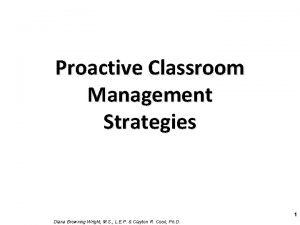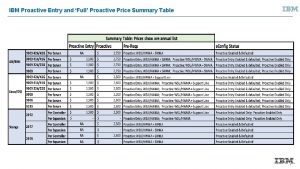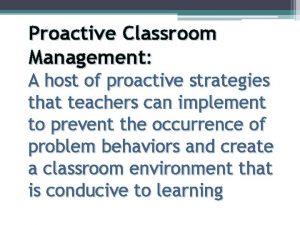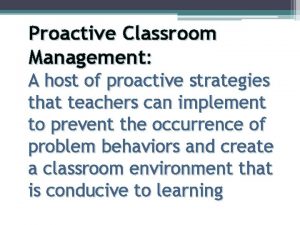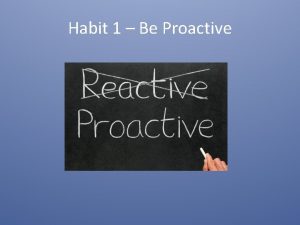Market selection and portfolio 1 Market selection Proactive



















- Slides: 19

Market selection and portfolio 1. Market selection – Proactive or Reactive? 2. Primary markets, secondary markets, etc. 3. Dynamics 4. Segments, niches and single customers © 2018 Taylor & Francis

Market selection – Proactive or Reactive? Proactive Market research Reactive ? Networks Decision criteria Here and now Planned Unplanned © 2018 Taylor & Francis

Preferences, buyer behaviour, laws and regulations, business practices, market mechanisms, Everything is new distribution channels Theyetc. don’t know you Inertia and loyalties “Things are working alright here – so why change? ? ” Difficult to convince customers Incumbents will fight back They know the market (much better than you) They play the national card You don’t know how competitors react fish for votes Politicians Challenges entering new markets! So go “softly”! BI/C. A. Solberg 2012 © 2018 Taylor & Francis

Where to go? There are so many decision criteria Market size Communication Access to distribution channels Existing market position Political considerations Tariffs Consumption and quotas patterns Exchange Network Economic rate risk Political relations stability Competition stability Logistics Market Access to Financial Cultural growth key customers risk distance But which ones matter? © 2018 Taylor & Francis

Needs of the decision maker Reduce uncertainties Screening/market research Seize opportunities Leads from the network Limit ex ante costs Limit ex post costs Institutional “norms” © 2018 Taylor & Francis

Three approaches – three explanations The “textbook” approach - Rational, optimal - Rules based, economic analysis “full” information? The network explanation - Boundedly rational, satisficing - Coincidental risk of failure? Institutions explanation - Boundedly rational, satisficing - “Rules” based encourage/discourage? © 2018 Taylor & Francis

A systematic approach may help you! How important? Score Importance x score Access to distribution channels Market size Political considerations Existing market position Tariffs and quotas Consumption patterns Exchange rate risk , 00 , 10 , 05 , 00 , 05 , 10 (7) 10 4 3 (3) 3 8 , 00 1, 00 , 20 , 15 , 00 , 15 , 80 Economic stability Political stability Competition Market growth Access to key customers Logistics Financial risk Cultural distance Communication , 05 , 20 , 15 , 10 , 05 , 01 , 04 8 7 6 10 4 4 7 6 2 , 40 , 35 , 30 2, 00 , 60 , 40 , 35 , 06 , 08 © 2018 Taylor & Francis S=6, 84

The scores differ from country to country How important? Score Importance x score Access to distribution channels Market size Political considerations Existing market position Tariffs and quotas Consumption patterns Exchange rate risk , 00 , 10 , 05 , 00 , 05 , 10 (7) 7 5 4 (3) 7 9 , 00 , 70 , 25 , 20 , 00 , 35 , 90 Economic stability Political stability Competition Market growth Access to key customers Logistics Financial risk Cultural distance Communication , 05 , 20 , 15 , 10 , 05 , 01 , 04 8 10 3 4 6 7 8 8 8 , 40 , 50 , 15 , 80 , 90 , 70 , 40 , 08 , 32 © 2018 Taylor & Francis S=6, 65

The weights differ from firm to firm How important? Score Importance x score Access to distribution channels Market size Political considerations Existing market position Tariffs and quotas Consumption patterns Exchange rate risk , 05 , 10 , 00 , 15 , 05 7 7 (5) 4 3 7 9 , 35 , 70 , 00 , 20 , 15 , 35 , 45 Economic stability Political stability Competition Market growth Access to key customers Logistics Financial risk Cultural distance Communication , 05 , 15 , 00 , 10 , 05 , 01 , 04 8 10 (3) 4 6 7 8 8 8 , 40 1, 50 , 00 , 40 , 60 , 35 , 40 , 08 , 32 © 2018 Taylor & Francis S=6, 25

Is the systematic approach the solution? Advantages “All” relevant factors are considered Internal process – difficult to complain later Awareness of critical factors among managers Disadvantages A lot of information is required So – it depends Figures are translated into doubtful scores Too systematic => loss of opportunities Lack of flexibility © 2018 Taylor & Francis

Preparedness for internationalisation Adult Child Multinational systematic market selection Global systematic market selection Assertive one by one / region by region Opportunity seeking Acquisitions The globe is our home Market portfolio configuration depends on competition Unmethodical or random market selection Customer oriented market selection Gradual and one by one – coincidental; neighbouring or culturally similar markets Where are strategic customers located? Multilocal Industry globality Global Market selection approach in different strategic positions © 2018 Taylor & Francis

Preparedness for internationalisation Decision process Systematic, opportunity seeking and The multinational player The global market leader rational. Market selection depends Decision process (to a certain. Adult extent) on objective Market. The selection “irrelevant” globe isisour home criteria. One by one – because the firm is operating in or region by region Need“all to be present in every virtually major markets”. Frequent use of market research and Opportunity seeking major / region Important to market be strong in sometimes advanced techniques. Acquisitions competitors’ own strongholds! Stakes are too high not to! Still: institutions guide selection Market research and advanced The bold newcomer The careful newcomer techniques are used to decide how Decision process where. Where are strategic One by one – coincidental rather than Intuitive, based on hearsay, random Decision processlocated? customers neighbouring or contacts and networks. Often Based on networks and industry similar markets neighbouring but piggybacking contacts. Location of key potential Child markets, culturally often leads the exporter to “uncharted customers is more relevant than waters”. country characteristics. Multilocal Scant use of advanced techniques. Information capture through market research is too costly - and limited competence reduces its worth. Follow-the-crowd institutions. Global Scant use of advanced techniques. Information through networks; extensive market research is too costly and takes too long. Industry globality Market selection approach in different strategic positions © 2018 Taylor & Francis

Market growth Market selection is one thing – market configuration is another matter! Market position in local market © 2018 Taylor & Francis

High Market growth Investment markets Exploration markets Peripheral markets “Accordion” markets Established markets Low Pull-out markets Strong Weak Market position in local market International market portfolio BI/C. A. Solberg 2012 Based on BCG © 2018 Taylor & Francis

Medium-term market growth Investment markets High Exploration markets Mexico Ukra-Sell through independent reps ine -Establish your own sales subsidiary Taiwan -Adapt to local market Nether Ice -Build market shares by accessing key US-Evaluate competitors Peripheral markets land marketing channels and adapting France marketing programmes “Accordion” -Exploit production markets capacity -Use the price mechanism (marginal Thai Malay land market pricing) to exploit -opportunities Respond to unsia -Use trading houses or distributors Colom solicited orders bia -Sell standard commodity Established markets Low -Assess future growth prospects -Reassert your operation mode Norway -Strengthen your relations with your distribution channels -Innovate your marketing Sweden strategy (positioning, new channels etc) Strong Pull-out markets Is it for some reason Nigeria important to stay in this market? Weak Market position in local market Different strategic approaches in different markets Cases plotted in the BCG matrix © 2018 Taylor & Francis

Two opposing strategies for small firms in international markets Concentration on few markets Niches in international markets The aim should be to achieve broad coverage in selected (neighbouring? ) markets in order to reap the fruits of market share. The aim should be to identify a small segment of “international” customers, with the same characteristics across countries, so as to achieve scale and position in the niche Consequences for the marketing mix and for the organisation? © 2018 Taylor & Francis

Small segment of the market Barriers to entry - Technological solution - Ability to adapt - Specialisation - Relationships - “Strategic fit” - Service level - and more - Too small for competitors - Too costly for competitors - Those who try will have to try really hard! What is a niche? BI/C. A. Solberg 2012 © 2018 Taylor & Francis

Niches in international markets 1. What is a niche? 2. What does it do to you? 3. How can you develop niches in international markets? BI/C. A. Solberg 20012 © 2018 Taylor & Francis A niche is a small segment of the market where your offering is preferred by the buyers. It helps you to rationalise your efforts, cut costs, increase your service level and knowledge about customers, distinguish yourselves from competitors and thereby - get a higher margin than in the ”mass market”. Customer orientation, learning, learning and then: consistency, consistency and doing the job right – every time, so as to be preferred!

Market share Low Marketing expansion Born Global Networking Supply chain member Market concentration High Low World wide competition with market leaders High Number of countries Growth strategies for niche marketers (based on Doole and Lowe 2008) © 2018 Taylor & Francis
 Segmentation levels
Segmentation levels Mission statement as a student
Mission statement as a student Screening models in project management
Screening models in project management Simplified scoring model in project management
Simplified scoring model in project management Leader challenger follower nicher
Leader challenger follower nicher Discuss the various steps involved in portfolio development
Discuss the various steps involved in portfolio development Project portfolio management matrix
Project portfolio management matrix Online portfolio selection
Online portfolio selection Retroactive vs reactive
Retroactive vs reactive Repressed memories
Repressed memories Proactive planning and reactive planning
Proactive planning and reactive planning Proactive and reactive change
Proactive and reactive change Two way selection and multiway selection
Two way selection and multiway selection Two way selection and multiway selection in c
Two way selection and multiway selection in c Mass selection and pure line selection
Mass selection and pure line selection Systematic attempt to specify threats to project plan
Systematic attempt to specify threats to project plan Sms 4 pillars
Sms 4 pillars Goodyear proactive solutions
Goodyear proactive solutions Proactive international pr
Proactive international pr Diana browning
Diana browning



















